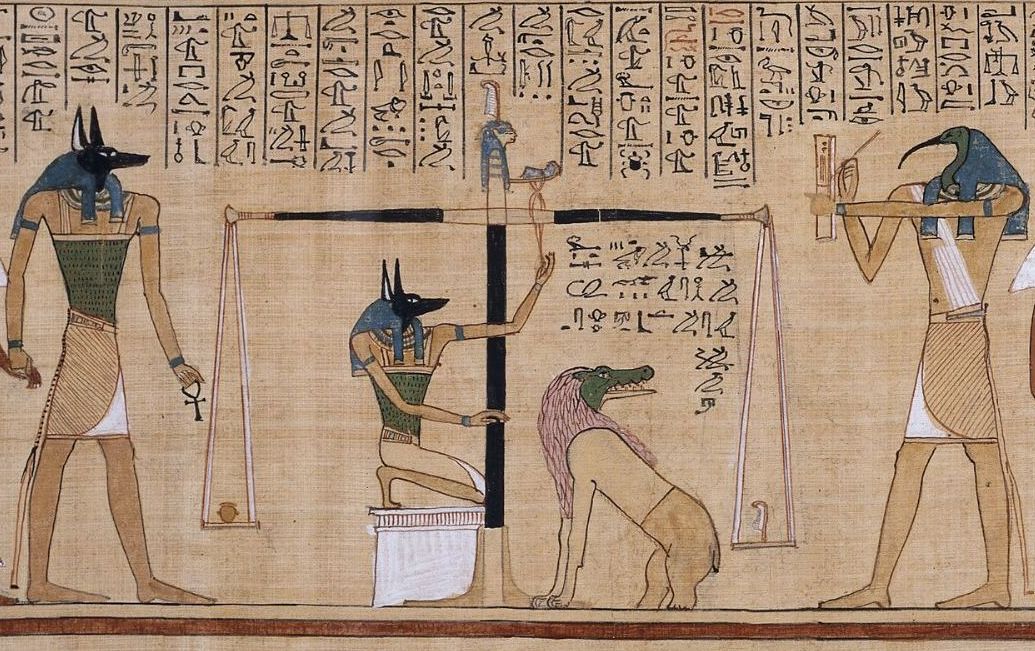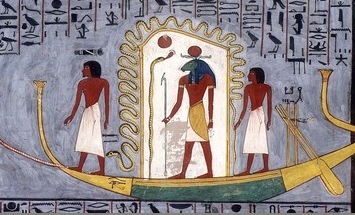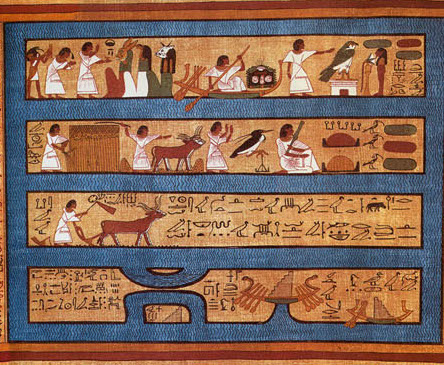|
Imentet
Imentet (Ament, Amentet or Imentit, meaning "She of the West") was a goddess in ancient Egyptian religion representing the necropolises west of the Nile. She was the consort of Aqen, a god who guided Ra through parts of the underworld. Although she was never officially worshipped, she was mentioned in various hymns and passages of the Book of the Dead. Role As goddess of the deceased, she lived in a tree looking out at the entrance to the Duat (underworld). Her main job, other than being a minor fertility goddess, was to offer food and drink to the newly dead, which would restore their spirits enough to travel to the "field of reeds" which is often equated with paradise in ancient Egyptian religion by modern authors, however, she was so closely linked with Hathor and Isis in their afterlife roles that she may be less an independent deity than an alternate form of those two goddesses.Wilkinson, Richard H. (2003). The Complete Gods and Goddesses of Ancient Egypt. Thames & Hudson ... [...More Info...] [...Related Items...] OR: [Wikipedia] [Google] [Baidu] |
Hathor
Hathor ( egy, ḥwt-ḥr, lit=House of Horus, grc, Ἁθώρ , cop, ϩⲁⲑⲱⲣ, Meroitic: ) was a major goddess in ancient Egyptian religion who played a wide variety of roles. As a sky deity, she was the mother or consort of the sky god Horus and the sun god Ra, both of whom were connected with kingship, and thus she was the symbolic mother of their earthly representatives, the pharaohs. She was one of several goddesses who acted as the Eye of Ra, Ra's feminine counterpart, and in this form she had a vengeful aspect that protected him from his enemies. Her beneficent side represented music, dance, joy, love, sexuality, and maternal care, and she acted as the consort of several male deities and the mother of their sons. These two aspects of the goddess exemplified the Egyptian conception of femininity. Hathor crossed boundaries between worlds, helping deceased souls in the transition to the afterlife. Hathor was often depicted as a cow, symbolizing her maternal a ... [...More Info...] [...Related Items...] OR: [Wikipedia] [Google] [Baidu] |
Isis
Isis (; ''Ēse''; ; Meroitic: ''Wos'' 'a''or ''Wusa''; Phoenician: 𐤀𐤎, romanized: ʾs) was a major goddess in ancient Egyptian religion whose worship spread throughout the Greco-Roman world. Isis was first mentioned in the Old Kingdom () as one of the main characters of the Osiris myth, in which she resurrects her slain brother and husband, the divine king Osiris, and produces and protects his heir, Horus. She was believed to help the dead enter the afterlife as she had helped Osiris, and she was considered the divine mother of the pharaoh, who was likened to Horus. Her maternal aid was invoked in healing Spell (paranormal), spells to benefit ordinary people. Originally, she played a limited role in royal rituals and temple rites, although she was more prominent in funerary practices and magical texts. She was usually portrayed in art as a human woman wearing a throne-like hieroglyph on her head. During the New Kingdom (), as she took on traits that originally belo ... [...More Info...] [...Related Items...] OR: [Wikipedia] [Google] [Baidu] |
Emblem Of The West (hieroglyph)
The Egyptian hieroglyph Emblem of the West ( Gardiner no. R13 𓊿 or R14 𓋀) represents the goddess Imentet, personification of the afterlife. It is composed of a hawk or ostrich feather. The alternate version of the symbol contains the complete figure of the hawk, for Horus, with the feather extending sideways, making it similar to the iat standard, surmounted by individual gods. The feather is associated with the headdress worn by the Libyans. The lower part of the hieroglyph contains the vertical form of the "folded cloth" (S29 𓋴) . As an ideogram, the hieroglyph represents ''imnt'' "west" or ''wnmy'' "right".''How to Read Egyptian Hieroglyphs'', Collier and Manley, Character "E7", p. 139. ''Hieroglyphics: The Writings of Ancient Egypt'', Betro, p. 212A, ''Emblem of the West''. File:Hieroglyphs.jpg, Hieroglyphs from Ankhnesneferibre's coffin; she was a Divine Adoratrice of Amun File:Stelae front.jpg, A stela.5 registers of hieroglyphs read from upper right-to-left ... [...More Info...] [...Related Items...] OR: [Wikipedia] [Google] [Baidu] |
Aqen
Aqen was a rarely mentioned ancient Egyptian deity of the underworld. He is first mentioned in the famous Book of the Dead. There, he guided the sun god Ra as the "protector of Ra's celestial bark" by "bringing the ''shenw''-ring to his majesty". He was also described as the "mouth of the time", from which the gods and demons pulled the "rope of time", as described in the tomb of king Seti I.Erik Hornung, Marsha Hill: ''The tomb of Pharaoh Seti I''. Artemis Verlag, 1991, , pp. 19. See also * Kherty * Charon * Duat The Duat ( egy, dwꜣt, Egyptological pronunciation "do-aht", cop, ⲧⲏ, also appearing as ''Tuat'', ''Tuaut'' or ''Akert'', ''Amenthes'', ''Amenti'', or ''Neter-khertet'') is the realm of the dead in ancient Egyptian mythology. It has been ... References Egyptian death gods Underworld gods Egyptian gods Egyptian underworld {{Egyptian-myth-stub Time and fate gods ... [...More Info...] [...Related Items...] OR: [Wikipedia] [Google] [Baidu] |
Ancient Egyptian Religion
Ancient Egyptian religion was a complex system of polytheistic beliefs and rituals that formed an integral part of ancient Egyptian culture. It centered on the Egyptians' interactions with many deities believed to be present in, and in control of the world. Rituals such as prayer and offerings were provided to the gods to gain their favor. Formal religious practice centered on the pharaohs, the rulers of Egypt, believed to possess divine powers by virtue of their positions. They acted as intermediaries between their people and the gods, and were obligated to sustain the gods through rituals and offerings so that they could maintain Ma'at, the order of the cosmos, and repel Isfet, which was chaos. The state dedicated enormous resources to religious rituals and to the construction of temples. Individuals could interact with the gods for their own purposes, appealing for help through prayer or compelling the gods to act through magic. These practices were distinct from, but closel ... [...More Info...] [...Related Items...] OR: [Wikipedia] [Google] [Baidu] |
Necropolises
A necropolis (plural necropolises, necropoles, necropoleis, necropoli) is a large, designed cemetery with elaborate tomb monuments. The name stems from the Ancient Greek ''nekropolis'', literally meaning "city of the dead". The term usually implies a separate burial site at a distance from a city, as opposed to tombs within cities, which were common in various places and periods of history. They are different from grave fields, which did not have structures or markers above the ground. While the word is most commonly used for ancient sites, the name was revived in the early 19th century and applied to planned city cemeteries, such as the Glasgow Necropolis. Necropoli in the ancient world Egypt Ancient Egypt is noted for multiple necropoleis. Ancient Egyptian funerary practices and beliefs about the afterlife led to the construction of several extensive necropoleis to secure and provision the dead in the hereafter. These necropoleis are therefore major archaeological sit ... [...More Info...] [...Related Items...] OR: [Wikipedia] [Google] [Baidu] |
Nile
The Nile, , Bohairic , lg, Kiira , Nobiin language, Nobiin: Áman Dawū is a major north-flowing river in northeastern Africa. It flows into the Mediterranean Sea. The Nile is the longest river in Africa and has historically been considered the List of rivers by length, longest river in the world, though this has been contested by research suggesting that the Amazon River is slightly longer.Amazon Longer Than Nile River, Scientists Say Of the world's major rivers, the Nile is one of the smallest, as measured by annual flow in cubic metres of water. About long, its drainage basin covers eleven countries: the Democratic Republic of the Congo, Tanzania, Burundi, Rwanda, Uganda, Kenya, Ethiopia, Erit ... [...More Info...] [...Related Items...] OR: [Wikipedia] [Google] [Baidu] |
Book Of The Dead
The ''Book of the Dead'' ( egy, 𓂋𓏤𓈒𓈒𓈒𓏌𓏤𓉐𓂋𓏏𓂻𓅓𓉔𓂋𓅱𓇳𓏤, ''rw n(y)w prt m hrw(w)'') is an ancient Egyptian funerary text generally written on papyrus and used from the beginning of the New Kingdom (around 1550 BCE) to around 50 BCE. The original Egyptian name for the text, transliterated ''rw nw prt m hrw'', is translated as ''Book of Coming Forth by Day'' or ''Book of Emerging Forth into the Light''. "Book" is the closest term to describe the loose collection of texts consisting of a number of magic spells intended to assist a dead person's journey through the ''Duat'', or underworld, and into the afterlife and written by many priests over a period of about 1,000 years. Karl Richard Lepsius introduced for these texts the German name ''Todtenbuch'' (modern spelling ''Totenbuch''), translated to English as Book of the Dead. The ''Book of the Dead'', which was placed in the coffin or burial chamber of the deceased, was part of a trad ... [...More Info...] [...Related Items...] OR: [Wikipedia] [Google] [Baidu] |
Duat
The Duat ( egy, dwꜣt, Egyptological pronunciation "do-aht", cop, ⲧⲏ, also appearing as ''Tuat'', ''Tuaut'' or ''Akert'', ''Amenthes'', ''Amenti'', or ''Neter-khertet'') is the realm of the dead in ancient Egyptian mythology. It has been represented in hieroglyphs as a star-in-circle: 𓇽. The god Osiris was believed to be the lord of the underworld. He was the first mummy as depicted in the Osiris myth and he personified rebirth and life after death. The underworld was also the residence of various other gods along with Osiris. The geography of the ''Duat'' is similar in outline to the world the Egyptians knew: There are realistic features like rivers, islands, fields, lakes, mounds and caverns, but there were also fantastic lakes of fire, walls of iron, and trees of turquoise. In the ''Book of Two Ways'' (a Coffin Text) there is even a map-like image of the ''Duat''. Resident souls, gods, and demons The ''Duat'' was also a residence for various gods, including Osiri ... [...More Info...] [...Related Items...] OR: [Wikipedia] [Google] [Baidu] |
Underworld
The underworld, also known as the netherworld or hell, is the supernatural world of the dead in various religious traditions and myths, located below the world of the living. Chthonic is the technical adjective for things of the underworld. The concept of an underworld is found in almost every civilization and "may be as old as humanity itself". Common features of underworld myths are accounts of living people making journeys to the underworld, often for some heroic purpose. Other myths reinforce traditions that entrance of souls to the underworld requires a proper observation of ceremony, such as the ancient Greek story of the recently dead Patroclus haunting Achilles until his body could be properly buried for this purpose. Persons having social status were dressed and equipped in order to better navigate the underworld. A number of mythologies incorporate the concept of the soul of the deceased making its own journey to the underworld, with the dead needing to be taken a ... [...More Info...] [...Related Items...] OR: [Wikipedia] [Google] [Baidu] |
Aaru
__NOTOC__ In ancient Egyptian mythology, Aaru (; egy, jꜣrw "Reeds, rushes"), known also as '' sḫt-jꜣrw'' or the Field of Reeds, is the heavenly paradise where Osiris rules. It has been described as the '' ka'' (a part of the soul) of the Nile Delta. The ancient Egyptians believed that the soul resides in the heart and so, upon death, the Weighing of the Heart occurred. Each human heart is weighed on a giant scale against an ostrich feather, which represents the concept of Maat. Those souls which balance the scales are allowed to start a long and perilous journey to the Field of Reeds, where they will exist in pleasure for all eternity. Hearts heavy with evil tip and fall into the crocodilian jaws of the demon Ammit. After this "second death", the soul is doomed to restlessness in Duat. The souls who qualify undergo a long journey and face many perils before reaching Aaru. Once they arrive, they enter through a series of gates. The exact number of gates varies accordi ... [...More Info...] [...Related Items...] OR: [Wikipedia] [Google] [Baidu] |
La Tombe De Horemheb (KV
LA most frequently refers to Los Angeles, the second largest city in the United States. La, LA, or L.A. may also refer to: Arts and entertainment Music * La (musical note), or A, the sixth note * "L.A.", a song by Elliott Smith on ''Figure 8'' (album) * ''L.A.'' (EP), by Teddy Thompson * ''L.A. (Light Album)'', a Beach Boys album * "L.A." (Neil Young song), 1973 * The La's, an English rock band * L.A. Reid, a prominent music producer * Yung L.A., a rapper * Lady A, an American country music trio * "L.A." (Amy Macdonald song), 2007 * "La", a song by Australian-Israeli singer-songwriter Old Man River Other media * l(a, a poem by E. E. Cummings * La (Tarzan), fictional queen of the lost city of Opar (Tarzan) * ''Lá'', later known as Lá Nua, an Irish language newspaper * La7, an Italian television channel * LucasArts, an American video game developer and publisher * Liber Annuus, academic journal Business, organizations, and government agencies * L.A. Screenings, a tel ... [...More Info...] [...Related Items...] OR: [Wikipedia] [Google] [Baidu] |
_(Vallée_des_Rois_Thèbes_ouest)_-2.jpg)








